Destiny’s Daughter
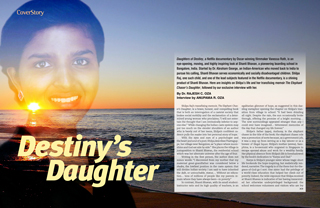
Daughters of Destiny, a Netflix documentary by Oscar-winning filmmaker Vanessa Roth, is an eye-opening, moving, and highly inspiring look at Shanti Bhavan, a pioneering boarding school in Bangalore, India. Started by Dr. Abraham George, an Indian-American who moved back to India to pursue his calling, Shanti Bhavan serves economically and socially disadvantaged children. Shilpa Raj, one such child, and one of the lead subjects featured in the Netflix documentary, is a shining product of Shanti Bhavan. Here are insights on Shilpa’s life and her transfixing memoir The Elephant Chaser’s Daughter, followed by our exclusive interview with her.
Shilpa Raj’s transfixing memoir, The Elephant Chaser’s Daughter, is a brave, honest, and compelling book that is both an interrogation of a casteist society that brakes social mobility and the exclamation of a determined young woman who proclaims, “I will not entertain the thought that I am intrinsically inferior to anyone else.” While changing the Indian caste system may put too much on the slender shoulders of an author who is barely out of her teens, Shilpa’s confident cadence pulls the reader into her personal story of hope.
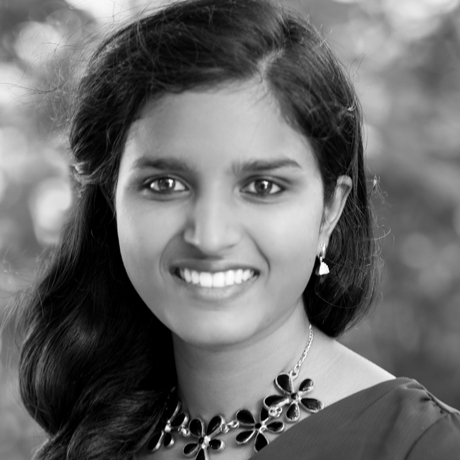
(Left) Shilpa Raj: “From invisible to unstoppable.”
With the eyes and ears of a psychologist and the heart and soul of a poet, Shilpa describes Thattaguppe, her village near Bangalore, as “a place where moonshine and God sat side by side.” She places the village in juxtaposition to Shanti Bhavan, the residential school which was her alternate universe after the age of four.
Writing in the first person, the author does not mince words: “I discovered from my mother that my maternal great-grandfather was considered below a shudra, the lowliest position in the caste system that still divides Indian society. I am said to have inherited the dalit, or untouchable, status…. Without an education… tens of millions of people like my parents remain where they have always been—in poverty.”
In contrast, Shanti Bhavan, with its small studentinstructor ratio and its high quality of teachers, is an egalitarian glimmer of hope, as suggested in this dazzling metaphor opening the chapter on Shilpa’s transition from village to school: “It had been drizzling all night. Despite the rain, the sun occasionally broke through, offering the promise of a bright morning…. The new surroundings appeared stranger than any I could ever have imagined… bittersweet memories of the day that changed my life forever.”
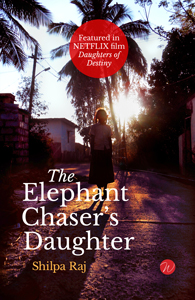
Shilpa’s transfixing memoir (left) is taking her places.
Shilpa’s father (appa), Anthony, is the elephant chaser in the title of the book; the elephant chaser role was a promotion of sorts because, as a government job, it was a step up from serving as a day laborer or as a brewer of illegal liquor. Shilpa’s mother (amma), Sarophina, is a housemaid who migrated to Singapore to escape spousal abuse and work for a wealthy family. Her physical absence from Shilpa’s life is foreshadowed by the book’s dedication to “Kavya and Dad.”
Kavya is Shilpa’s younger sister whose tragic short life bookends the hope-inspiring, but realistically rendered, narrative. The tragedy is of the there-but-for-thegrace-of-God-go-I sort. One sister had the privilege of a world-class education that helped her climb out of poverty. Indeed, the wide exposure that Shilpa received at Shanti Bhavan is indicative of her having transcended her otherwise underprivileged background: the school welcomes volunteers and visitors who are Ivy Leaguers, high-tech executives, Broadway artists, world-class athletes, and journalists. In 2004, New York Times columnist Thomas Friedman wrote a widely-read piece titled “Making India Shine” about Shanti Bhavan, inspiring many to donate time and money to this dusty slice of heaven on earth. No wonder this author-sister went on to see the world beyond Thattaguppe, indeed beyond Bangalore and India, most recently participating in a town-hall meeting hosted by The Obama Foundation.
The other sister “was a wildflower that swayed in the wind—a girl with uncontrollable energy and unexplainable dreams.” Kavya’s energy had no channel beyond mischief with local louts, and her dreams were thwarted by the shabbiness of the village school; the pixie life of this ancillary-sister is cut short by scandal not long after she complains to Sarophina that “you treat one daughter like a queen and the other like a slave.”
Given Shanti Bhavan’s inclusive strategy to uplift as many deserving families as possible within its constrained financial resources, the school admits only one child per family. Shilpa hit the proverbial jackpot that comes from a good education. Kavya, left behind in her village, was hit with an unsurprising case of sibling rivalry. Tragically, resentment, mixed with the riffraff that Kavya ran with, resulted in a fatal brew.
In the words of the aforementioned Shanti Bhavan documentary, Shilpa and Kavya are “daughters of destiny.” Shilpa, with a large dose of educational good fortune, is able to choose her destiny; but Kavya had the misfortune of having her destiny sealed in an ancient caste system with no future.
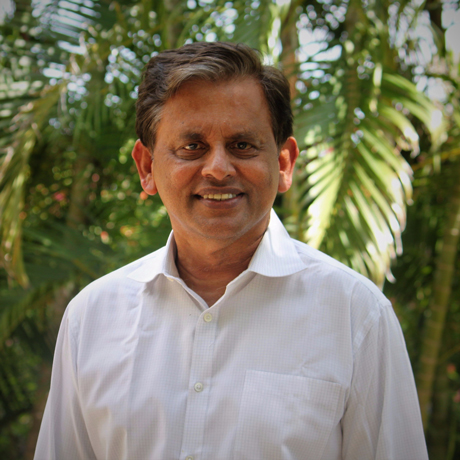
Dr. Abraham George, the man behind Shanti Bhavan, the pioneering school that is making hundreds of “invisible” children unstoppable.
The reader might assume that the “Dad” in the book’s dedication is Anthony. But early in the memoir, Shilpa writes about her first year at Shanti Bhavan when her parents would come to meet Dr. Abraham George, the founder of Shanti Bhavan, whom Shilpa “would later come to think of as Dad—different from father.” A more expansive book review is required to do service to Dr. George’s life story of leaving the financially rewarding comforts of American entrepreneurship to experience the philanthropic rewards of starting a school on a scrap of scorpion-infested land in the country of his birth. It must suffice here to note that Shanti Bhavan means “Haven of Peace,” and that due to the largesse of the George family and other donors, the school freely provided Shilpa (and continues to provide subsequent generations of low caste/class children) with a tolerant, empathetic, trustworthy, secure, loving, and peaceful academic setting. Abraham George has the leadership gift of an exemplary teacher who speaks to everyone he meets at their level. Having spent time with Dr. George, we are quite confident that he is equally comfortable going eye-to-eye with investment bankers at New York University‘s Stern School of Business where he is an Adjunct Professor, and comfortable telling Shilpa, “Look up, girl … Always look a person talking to you straight in the eye.”
While it helps to have a background in social justice or education policy to fully appreciate The Elephant Chaser’s Daughter, one need not have a degree from an elite university to know what Shilpa’s appa understood. After a spell of Shilpa behaving badly at school, Anthony gently scolded her: “‘What will you do if you are dismissed from Shanti Bhavan? You will have to marry some useless fellow in the village and end up having lots of babies,’ he said with tears filling his eyes.”
Shilpa Raj has the memoirist’s gift of introspectively looking at herself in a mirror, the social psychologist’s talent of looking at the world through a window, and the active humanist’s growth mind-set to recognize that in order to change one’s life and that of others, you must step out of your village door and act upon your aspirations. If the Raj family history is India’s caste history writ small, then perhaps Shanti Bhavan’s educational dream can be an international inspiration for the world to do better by all of our Kavyas and Shilpas.
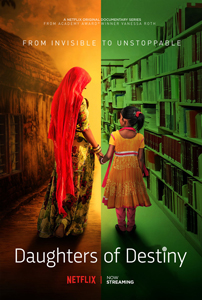
(Right) The Netflix documentary by an Oscar-winning filmmaker has given Shanti Bhavan and its students like Shilpa Raj a much deserved worldwide exposure.
Based on research from the World Bank, the return on one year of high school education for a girl correlates with a 25% increase in her career wages. The benefits extend to the next generation, because educated women have fewer, healthier, and better-educated children. With Mother’s Day around the corner, perhaps the aphorism about teaching a man to cook has even greater relevance to educating women. As society teaches our daughters of all socioeconomic backgrounds that they are entitled access to high-quality education, families eat for multiple lifetimes.
“Extreme poverty gives people extreme stress and very few coping mechanisms.”
In an exclusive interview with Khabar, conducted by ANUPAMA R. OZA who volunteered at Shanti Bhavan in 2011, Shilpa Raj speaks about her book, The Elephant Chasers Daughter, and about how her life has transformed thanks to her time at Shanti Bhavan.
Congratulations on The Elephant Chaser’s Daughter. Please tell Khabar readers why they should read your book.
My book offers an honest, first-hand experience of what life is like for one growing up poor and socially disadvantaged in modern-day India.
On a personal level, it is a coming-of-age story of a young girl struggling to find her voice while traversing between the two contrasting worlds she lives in—one of poverty and the other that offered a life-changing opportunity. But on a broader level, my work is a testimony to the dynamic impact that quality education and proper upbringing have not just on individual lives but on society at large.
For social entrepreneurs and leaders looking for inspiration, this book shows how one individual, Dr. Abraham George, the founder of Shanti Bhavan School, tackles poverty and generational social deprivation through an educational model that empowers children from disadvantaged backgrounds to overcome all hurdles and harness their potential to the fullest.
Which part of the book came easiest to you?
Honestly, there was actually no part of the writing process that came easy to me. Since this is a memoir, I had to constantly relive my past as a child
of poverty and recall the struggles with academics and self-esteem issues. Having to remember and repaint those experiences through words was often discomforting and emotionally difficult. Talking very honestly about my family and our past together was tough, too.
Which part was most challenging?
Writing about my family was most challenging. As a young child growing up in a boarding school, I felt both physically and emotionally distant from my family. Even more, I had to spend some of my school vacations at Shanti Bhavan because I didn’t feel my family could provide me with a safe environment. Those long years of living away from my family deepened my need to reconnect with them. And hence, when I finally sat down to interview my parents and other family members, I was totally unprepared for all that I was about to learn about my family’s past. The childhood stories of my parents helped me better understand them. As a result, I began to treat them with more empathy and kindness. Amidst tears and great laughter, I finally found my family and connected with them in ways I had never done before.
Which books have inspired your writing?
I was always an avid reader. I turned to books for inspiration and consolation when I was struggling emotionally as a teenager. I particularly enjoyed biographies and memoirs. I remember reading biographies on Franklin Roosevelt, Indira Gandhi, Mahatma Gandhi, Helen Keller, President Obama, and others while in school. I completely absorbed the inspiration and hope their stories offered.
What about contemporary writers in India and outside of India?
I admire many authors like Anita Desai, Harper Lee, Jhumpa Lahiri, Manto, Kamala Das, Manju Kapoor, and others. This is not an exclusive list by any means. In addition to modern writers, I enjoy reading classics such as the works of Tolstoy, Hemingway, and others. Each one has brought out the complexities of the human drama, which is most appealing to me.
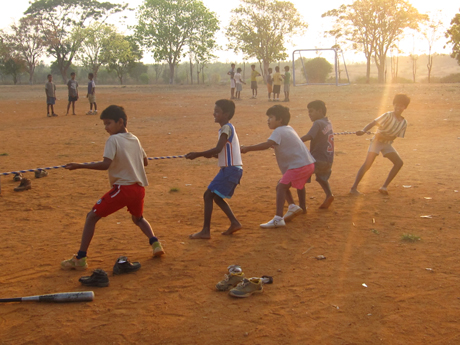
(Right) Shanti Bhavan kids at play. (Photo: Anupama Oza)
Please tell us about the responses you’ve received about your book...
…from Shanti Bhavan staff, faculty, and students.
My family at Shanti Bhavan has always been an integral part of my life as well as in my journey of writing this book. My schoolteachers and caretakers were very excited when the book first came out, and for days it was the central topic of discussion on campus. The younger children would constantly ask me about the experience of working on the book. I remember retelling those stories over and over again because everyone was curious to know what goes into writing and publishing a book.
My own peers who studied with me in school were happy for me and were eager to know if they were described in the book. Those who had read it mentioned how my individual experiences as a child living in two worlds resonated with their own struggles of finding a balance, and their present identity.
…from those still residing in your village, Thattaguppe.
Fearing jealousy spread among the neighbors, my family and I are very careful about how much we disclose about my life. But my father just can’t resist the temptation to brag about me—being the first in my village to get a Master’s degree, visit the U.S., and write a book. But within my own family, after seeing the wonders a good education has brought to my life, my uncles and aunts are determined and motivated to put their own children through school and ensure that they, too, have a good life.
...from the outside world.
When the book first came out, I was very nervous about how it would be perceived worldwide. But after receiving thoughtful feedback and comments on Amazon and Goodreads, I was very encouraged. I learnt to take criticism positively because these criticisms serve as useful reminders of how one can still improve and push one’s boundaries. I’ve been greatly humbled by the acceptance and positive reception that my book has received from readers both in India and abroad. Many have written to me sharing how relatable my experiences have been to their own. They also appreciate the fact that I was open and candid about even embarrassing incidents in my life. Others have applauded me for raising attention on social issues. I am encouraged to write another book in the not-too-distant future.
Apologies if this question is too sensitive. If your sister Kavya were still in this world and she read The Elephant Chaser’s Daughter, what would she tell you about the book?
I can imagine her certainly being quite dumbfounded by the whole ordeal of someone in her family having a book published, since it would have been an alien concept to her. Since Kavya didn’t know English, I would have had to read small chapters at a time and explain everything in Kannada. She would really have enjoyed that. Knowing her well, I know Kavya would have bragged about it to her friends in school and shown
them the hardcopy to make sure they didn’t think she was once again playing tricks with her wild imagination, which she was quite known for.
There’s so much my sister didn’t know about my own life in school and at home. Learning more about me, I think, would have helped her to understand me better, both as her sister and as a person. She always assumed that my life was perfect, and that made her feel angry and jealous towards me. But learning about my life—its challenges and its joys and sorrows—and understanding who I am with all my faults and strengths, I like to think, would have made her more accepting of me. Probably, it would have helped us grow closer to each other, which was something I always hoped would happen.
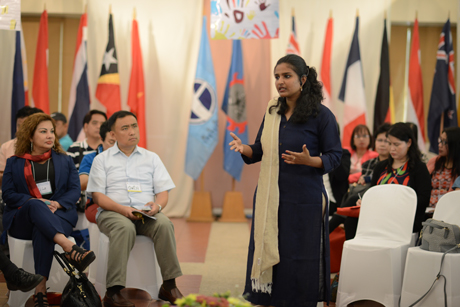
(Right) Shilpa Raj speaking at the International Conference on Inclusive Education in Manila.
What opportunities has the book opened for you? Which doors have opened?
My life has changed in many beautiful ways since the publication of my book. I’ve had people from all around the world reach out to me over social media to share their thoughts on my book as well as their own personal stories of struggle and triumph. It’s been
gratifying to connect with so many and gain a deeper understanding of the dynamics of the common human experience. I’ve also had the opportunity to speak at multiple events, both abroad and in India. I’ve spoken at schools and colleges during my trip to the U.S.,
and recently I shared my story at an International
Conference in Manila on Inclusive Education. In India, I’ve had the privilege of speaking at companies such
as Microsoft and TESCO Bangalore, and at various schools and social clubs.
I’ve been humbled by the newfound respect that I receive from people, both younger and older to me. I am flattered every time someone asks for my autograph. This is my first taste of professional success and it has motivated me to work harder and continue to push my boundaries. I now realize how fulfilling it is to reap the benefits of hard work and perseverance.
Personally, I’ve grown more confident as an individual and feel more determined to relentlessly pursue my dreams. I now know that dreams can come true.
We understand that you attended a Town Hall meeting convened by the Obama Foundation. How was that experience?
When I first learnt that I had been chosen to attend a Town Hall Meeting in Delhi convened by the Obama Foundation, I was simply overjoyed and flabbergasted. Everyone at Shanti Bhavan was just as excited as me, and I carried their excitement as well, as I listened to President Obama speak.
President Obama was just as I thought he would be—kind, wise, witty, humble, and extremely charming. There was no air of arrogance or unchecked self-importance around him, which amazed me, given how arrogantly the landlords and local leaders behave in my village.
By the end of the two-hour session, I also realized how much potential existed in our own country. I got to meet many distinguished individuals that day from the field of mental health, social service, public health, the education sector, female advocacy, environment and policy-making. I came away with a greater sense of optimism and hope.
It was a real honor to listen to President Obama speak in person. I consider him a great inspiration and I will always cherish the memories of this Town Hall session.
What are you presently doing by way of a job?
I graduated from college last June with a Master’s degree in Psychological Counseling. For eight months, I then taught classes on developmental psychology for the parents of children suffering from autism and other neurodevelopmental disorders. I also assisted the social work department of the Spastic Society of Karnataka, Bangalore, in doing intakes, observations, and counseling children with learning disabilities and other school related issues. This gave me a rich first-hand experience as a trainee counselor and furthered my desire to continue work in the field of mental health.
I am now preparing to go back to college to do a two-year MPhil course in Clinical Psychology. Pursuing this degree will make it possible for me to get licensed by the government as a psychological therapist. I will then be able to open my own clinic and practice, which has been a big dream for me. I want to specialize in child and adolescent psychology so that I can help children who are struggling emotionally and psychologically, as I wish someone had helped my sister who committed suicide at a young age of fourteen. I want to start something in my sister’s name so that her name may live on.
There are times when I feel that maybe it could be a program beyond clinics and we go to villages. The rural community is completely cut off from mental health facilities. I want to focus on them because extreme poverty gives people extreme stress and very few coping mechanisms.
Can you share a bit about your next writing
project?
I’ve been thinking about writing a collection of short stories based on true-life events. I have a wild imagination and fictional work excites me. In the
long run, I also want to document my own journey
as a social entrepreneur and a mental health professional in India.
After serving as an educator of systemically underserved children with Teach For America and at Shanti Bhavan, Anupama Oza received a Masters of Education from Harvard University; she now teaches in San Francisco.
Rajesh C. Oza, who for many years wrote Khabar’s "Satyalogue" column, is grateful for all of his teachers from India, Canada, and America; in addition to consulting, he now facilitates the interpersonal development of Stanford University’s MBA students.
Enjoyed reading Khabar magazine? Subscribe to Khabar and get a full digital copy of this Indian-American community magazine.
blog comments powered by Disqus










